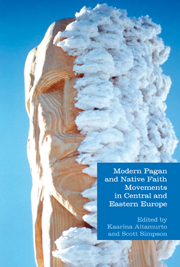Book contents
- Frontmatter
- Contents
- Contributors
- 1 Introduction: Modern Pagan and Native Faith Movements in Central and Eastern Europe
- Part I Overviews
- Part I Country Studies
- Part III Thematic Studies
- 18 The Ideology of Jan Stachniuk and the Power of Creation
- 19 “Imported” Paganisms in Poland in the Twenty-First Century: A Sketch of the Developing Landscape
- 20 The Russian-Language Internet and Rodnoverie
- Bibliography
- Index
19 - “Imported” Paganisms in Poland in the Twenty-First Century: A Sketch of the Developing Landscape
from Part III - Thematic Studies
- Frontmatter
- Contents
- Contributors
- 1 Introduction: Modern Pagan and Native Faith Movements in Central and Eastern Europe
- Part I Overviews
- Part I Country Studies
- Part III Thematic Studies
- 18 The Ideology of Jan Stachniuk and the Power of Creation
- 19 “Imported” Paganisms in Poland in the Twenty-First Century: A Sketch of the Developing Landscape
- 20 The Russian-Language Internet and Rodnoverie
- Bibliography
- Index
Summary
In Poland, the first bloom of autochthonic Neopaganism occurred in the mid-twentieth century. These Polish Neopagans generally delved into the Slavic tradition. However, since the 1990s, in addition to the whole range of autochthonic Slavic Neopagan groups or individuals referred to in Poland as Rodzimowierstwo, we can observe a numerically smaller but significant increase in interest in a wide variety of Neopaganisms that are not based in Polish culture. The concept of “imported Paganism” refers here to those which achieved their first popularity somewhere else in the world and only later acquired supporters in Poland. The leading forms of these imported Neopaganisms include four types: Wicca, Asatru, Neo-Shamanism, and Druidry. There are also some less commonly encountered imports to Poland, such as interest in the religions of the ancient peoples of the Mediterranean (especially Greece and Rome) or the Middle East (Egypt and Mesopotamia). We should also note that eclecticism and bricolage, which combine elements from different religious traditions into one system, potentially blurring the line between “native” and “imported” religion, are also frequently encountered in twenty-first-century Poland.
- Type
- Chapter
- Information
- Publisher: Acumen PublishingPrint publication year: 2013

